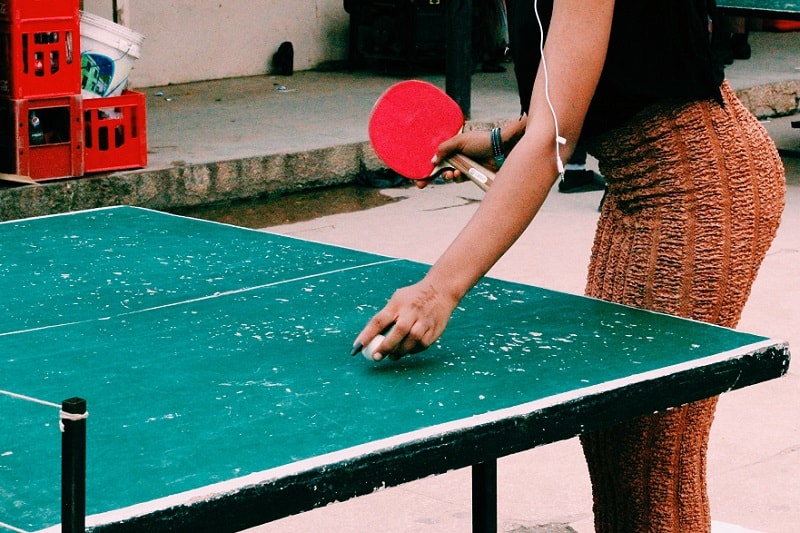Table tennis has been around for more than a century and grown from being a casual parlor sport to a highly competitive Olympics discipline which is followed world over by millions of fans. We look at the history and evolution of table tennis in this piece.
Table of Content
When and How was it Invented?
The game was first known when the Lawn Table tennis was brought to play indoors with equipment such as a table, paddles, and ball only. This was then being repeatedly practiced in the early 1880s due to winters.
The game then progressed to being a typical “parlor game” among other games for timely amusements. In those times, the trademark was called Ping Pong. (here’s more on why table tennis and ping pong aren’t the same any more)
Other names were created region-wise such as Whiff Waff, Parlor Tennis, Indoor Tennis, Pom-Pom, Pim-Pam, Netto, Clip Clap and so one. But the most common one that prevailed in those years was Ping Pong.
How Table Tennis Diverged from Ping Pong?
The trademark of Ping Pong equipment was held by English firm J. Jaques and Son, who invented this name in the 1800s and was later owned by Parker Brothers from the United States.
The game later had an association of its own called “The Ping Pong Association” formed in 1902. After that, the Ping-Pong tournament’s policy was that the game must include the equipment from the Ping Pong Tournament.
As this was now a concern of copyrights, the other matches that didn’t include the ping-pong brand equipment came up with “Table Tennis”.
The Ping Pong Association was already fragmented by 1905 and got dissolved, but the game still was being played all over the world by then.
This game then needed an International forum of recognition.
Three of the first few countries who joined hands to kick-start the The International Table Tennis Federation were Germany, England and Hungary. Sweden, India, Denmark, Czechoslovakia, Austria and Wales joined in later and by the 1990s, there were 160+ countries which became a part of the body.
Also Read:
- Why Do Table Tennis Players Inspect Each Other’s Rackets?
- Practicing Blocking Skills in Table Tennis
Early Days of Table Tennis
The game had already been spread worldwide from 1902 till the 1920s. Different migrants and tourists would adopt the game and take it back to their regions. This started to create interest and curiosity in people from all over the world about a game that doesn’t require any extra ground spaces and is convenient while being exciting as well.
Hungarians mainly dominated the game in its early days after the formation of ITTF, and their spirits have been genuinely recognized in terms of the game’s popularity, which stands to date.
The first World Championship was organized in 1927, exactly a year after ITTF’s formation and was obviously, won by a Hungarian, Dr. Jacobi.
Evolution of Table Tennis Equipment
There have been different kinds of equipment associated with table tennis which includes rackets, balls, net and table. Here’s a brief on the history of table tennis equipment.
The Rackets
Till the 1940s, the paddles used to be large and similar to the ones of Tennis. But by the time of the 1950s, sponge or the rubber sandwich was invented, which changed the game dynamics to a certain extent.
The rackets were now quite simple, light-weighted, and short with unique rubber coverings that add a spin and speed factor to the game, which is followed up till now.
The Balls
The Table Tennis balls have also been through a long journey of evolution for what they are today. Earlier, the same cork and rubber ones were used for table tennis, just like for tennis.
By the 1900s, the rubber balls were replaced with celluloid balls, which added a significant variation to the game giving a new bounce and style to the gameplay.
Later the plastic balls were introduced, which were for a long time not allowed in worldwide championships. But in the year 2016, plastic balls were allowed at World Championships and Olympics.
In the meanwhile, of material evolution, the size also faced its fair share of ups and downs. The ball’s size was reduced so much in the early days that viewers faced many difficulties in having an eye on the ball. So, by the 2000s, the size was finally increased to 40mm for enough visibility and convenience in playing.
You can get more about the table tennis ball in our exhaustive guide here.
The Net
The net used in earlier days was also much heightened, which was reduced by the time to 6 inches by the end of 1937, for more attack and defense gameplay.
The Table
The table used for this game was initially no different than the dining room tables. These tables were used for a long period without any change or advancement with rubber and cock balls.
After 1994, sports politics were now going smooth after the formation of USA Table Tennis, hence the committee thought to come up with some advancements. The tables were hence repainted along with an increase in the net’s height.
This was a bad decision because it made the game too slow and each point would continue for hours.
In the early 2000s, ITTF then internationally released a standard size and material for the tables. The material was then wooden with a standard size of 2.74 m in length and 1.53 m in width.
These dimensions are followed till date with adequate support to ball spin and speed.
Some concrete and steel net tables are also used till date in parks or open spaces, to resist damage.
Also Read:
Significant Events from the History
Since the formation to date, below mentioned are known as the milestones of table tennis evolution, which only a few know about. Have a look to go through history.
- 1901: First books were published about this game.
- 1926-1931: Maria Menyanszky was a consecutive five-time champion of the World Championship with 18 gold medals.
- 1930-1935: Victor Barna stands a five times winner of the world championship with a record of 22 gold medals and 40 medals overall.
- 1939: First championship that was organized out of Europe.
- 1950: Angelica Rosenau-Adelstein is known to be the one who bagged the title of champion six times consecutively and was the last non-Asian female to win a singles tournament.
- 1952: Hiroji Satoh was the person to use rubber rackets for the first time and win the title for the first time as a non-European.
- 1956: Tomie Okada-Okawa becomes the first female player to win the female championship title from Asia.
- 1959: Rong Guotuan becomes the first international champion from China for any sport.
- 2001: The game score was changed to 11 points from 21.
Interesting Historic Facts
Some events and acts took place out of nowhere, for the surprise of all those who witnessed. Such facts are hardly known to everyone and rare as well. Want to know about it? Have a look then!
1971: The act of Ping Pong Diplomacy took place, where China invited the USA, England, Canada, and Columbia to play a series of friendly matches of Ping-Pong.
This was a historic act as it was China’s first contact with the world after six straight years. Hence, this proved to be beneficial in promoting Table tennis and their political relations as well.
Table Tennis is now internationally recognized as the most popular indoor game in the world. It can be judged from a single fact that it’s racket rubber only, has a variety of more than 1600 designs with subtle differences and designs. Interesting, isn’t it?
Table Tennis as It Stands Today
With all the up-downs this game had to go through to become what it is today; the journey has indeed been quite long. Today, the game is famous in Europe and has worldwide recognition of Olympic Games Sport as well.
With all the advancements of this era, this game is still hoped to develop and get advanced in the upcoming times.
Table Tennis in Olympics
Table tennis’s growing fame made it possible for the game to be included in the Olympics Championship for the first time in history in 1988. At the Seoul Olympics that, table tennis was played as a part of the Olympics with both categories of singles and doubles for men and women.
Get more information on table tennis in the Olympics here.
Table Tennis X
With passing time, the people at the top made some alterations to the rules of table tennis and named it Table Tennis X. This version of table tennis is even more exciting than the original one.
This version is basically time-bound, which doubles the excitement of winning within the given time period. A single set is only 2 minutes long. The freestyle play motivates players.
Another interesting rule is known as “Wildcard”. Each player is given one chance per set to call “Wildcard” for that set. If that player wins, he gets to bag 2 points instead of one. Cool right?
Well that’s not all. If a player scores a win against the opponent who was on a wildcard, then he gets 4 points instead of 1. Moreover, on a serve or return, if the opponent doesn’t touch the ball, then the player gets 2 points!
This amazing series of scoring more than usual adds to the thrill of this version.
Here’s all that you wanted to know about Table Tennis X.
The Future
With the main table tennis body looking to push the sport even further to be able to cater to younger audiences, it does look like we could have multiple versions of the game for different markets. That augurs well for the sport with spillover from one format to the other expected, only helping grow table tennis to younger audiences.


